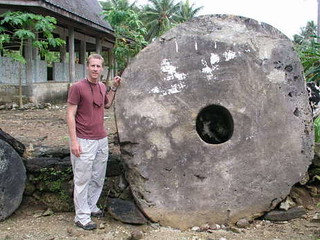
PREV ARTICLE
NEXT ARTICLE
FULL ISSUE
PREV FULL ISSUE
HOW YAP STONES PAVED THE WAY FOR BITCOINArthur Shippee also passed along this article found via The Explorator newsletter about a study that found similarities between modern bitcoins and the giant stone money of Yap. Thanks! Interesting parallels. -Editor In "Banking on Stone Money: Ancient Antecedents to Bitcoin," published in January 2020 in the journal Economic Anthropology, Scott M. Fitzpatrick of the University of Oregon Department of Anthropology teamed with Inman Research Scholar and finance professor Stephen McKeon of the Lundquist College of Business to explore Bitcoin's precedents as "rooted in the ancient past, which involved the production, movement, and use of traditional forms of 'currency,' the most visible and prominent of which were the famous stone money of Yap." In the paper, the authors discuss Bitcoin's origins and its consequences for global commerce, highlighting what might be learned by studying ancient stone currency. In particular, they note that the underlying technology powering Bitcoin, known as the blockchain, has much in common with the ledgers Yapese islanders used to document ownership of their enormous stone coins. Those stone coins were so heavy that islanders drilled holes through the center so they could be carried on long poles. The tradition predates European contact with the Yapese in 1783 and formed the basis of their monetary system. While it might seem like a giant stone coin would have little in common with Bitcoin, which has no physical presence, the sheer weight and difficulty of moving the rai from one holder to another creates a startling similarity. An owner of a rai might not take physical possession of it. They might leave it on the side of a road or leave it with its original owner who has bartered it for some good or service. So, the Yapese created an oral ledger of ownership for each rai, in effect a precomputer blockchain to detail the origin of each piece of stone money, its transactions and its ultimate holder. "Given that the actual possession of rai was often infeasible, an owner would deem it to be valuable only if they could trust that all participants in the economic system agreed on the record of ownership," Fitzpatrick and McKeon write. "Effectively, it was not a bearer asset; ownership was established solely through the ledger. Other similarities with Bitcoin follow. The difficulty of mining limestone, fashioning it into rai and then transporting the currency helps to limit supply and to create scarcity that prevents inflation. Bitcoin is mined by computers solving complex math problems at great and growing expense. There are some differences, of course. Bitcoins can be divided into smaller units while the Yapese had no system for spending smaller denominations of rai by breaking them into pieces. Finally, all Bitcoins are equal. A rai, however, derived specific value from its size and craftsmanship, adding an element of artwork to the currency. It isn't known if Nakamoto or his collaborators considered the Yapese, or ancient currencies, in their Bitcoin design. But it is known that some of the principles behind Bitcoin have been validated by history and that might offer a clue about the longevity and uses of blockchain based cryptocurrency as an asset class. To subscribe to Explorator, send a blank email message to: explorator+subscribe@groups.io. -Editor
To read the complete article, see:
To read earlier E-Sylum articles, see:
Wayne Homren, Editor The Numismatic Bibliomania Society is a non-profit organization promoting numismatic literature. See our web site at coinbooks.org. To submit items for publication in The E-Sylum, write to the Editor at this address: whomren@gmail.com To subscribe go to: https://my.binhost.com/lists/listinfo/esylum All Rights Reserved. NBS Home Page Contact the NBS webmaster 
|


